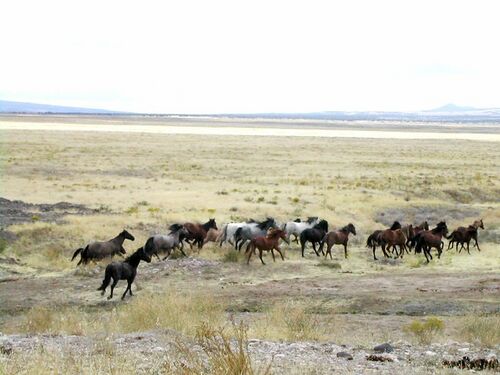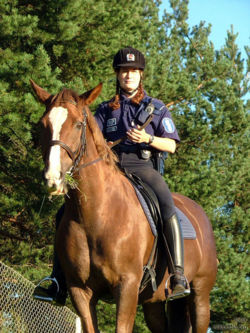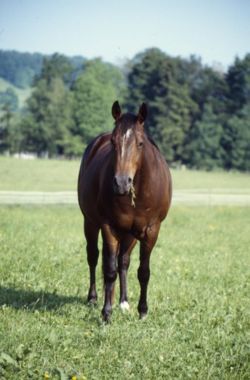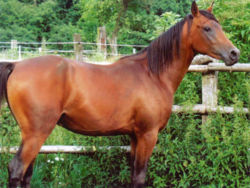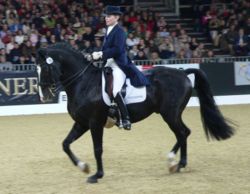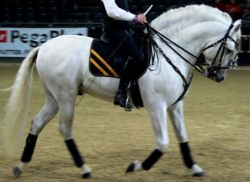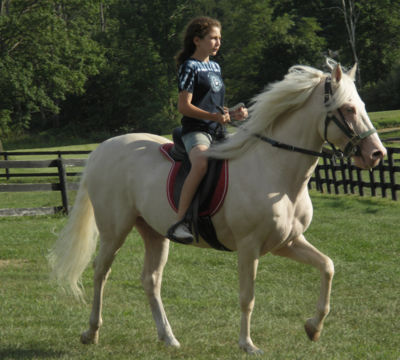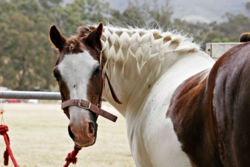Horse colors
Horses have coats in shades of black, red, white, brown and grey, and mane and tail colors that either match, or contrast, with color of the coat. For centuries, there has been speculation that speed and color might be related in horses, and color has been, rightly or wrongly, an attribute dear to breeders of racehorses - as well as those that bet on them!
Those colors lend a distinctive appearance to the individual horse, and sometimes, typify an entire breed of horses. The genetics behind the inheritance of color is a fascinating subject in and of itself, and of practical interest to the horse breeder. Knowledge of colors and markings are important in identifying horses, and in selective breeding for desirable traits. Not only are some colors and patterns in increased demand, but sometimes these features are written into the breed standard of purebred horses. The Paint horse, and the Appaloosa, for example, were originally defined largely for the pattern of their coats and their value is affected by these qualities. The Lipizzaner horses, famous as the "dancing white stallions" are (like almost all "white" horses) actually grey. Other varieties of horses, like the American mustang are noted to come in all patterns and colors [1].
Speculation about just how color and pattern is inherited in horses has probably been around as long as horse breeding has been, but it is only in the last decades that an understanding of the genetics has become sophisticated enough to go beyond speculation. Several DNA tests for color genes are now available, and a blood or hair root sample can reveal the genotype of a mare and stallion, allowing the breeder to predict the appearance of their offspring. Since some of those genes also influence eye and skin color, and the color of hoofs, the probability of white markings like socks, snipes, and blazes, accuracy of that prediction can go beyond simple base coat color.
Solid colors
The basic pigments that color horses' hair are red and black. [[2]]. Other genes modify the expression of these pigments.
Red: chestnut or sorrel?
Red-haired horses are called different names by English-speaking people in different geographic areas. Equestrians from the United Kingdom, and countries (like Canada) of the British commonwealth, usually call these horses chestnut. Americans from the East Coast, who live in States that were originally English colonies and tend, to this day, to ride with tack similar to that used in Britain (English style riding), also call them chestnut, whereas Americans from Western USA refer to them as sorrel. A style of riding in the West of the USA developed using larger saddles with a pommel and looser contact with the horse called western style riding. The use of the words, "chestnut" and "sorrel" carries over to breeds that are most typically used for either English or Western styles of riding - so that the quarter horses so popular for western riding will be called sorrel, but a warmblood or thoroughbred-draft cross competing in high level dressage or jumping a Grand Prix will be called chestnut, despite the fact that all might be the very same shade of red, and might be competing (in different events) in the very same location.
However, whatever its called, colorwise, red is red; and genetically, sorrel and chestnut horses are the same. What makes their hair that color is a pigment called phaeomelanin. By and large, every horse produces this pigment. The exceptions will be discussed in a later section (see [True White]).
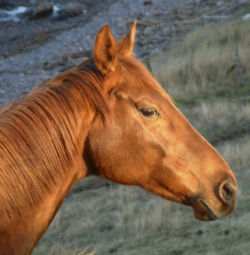
Black hairs: the E gene
The black color of horse hair is made by the pigment eumelanin. When a hair is colored by both red and black pigment, the black is what shows, masking the red. One portion of the horse's genome is the "extension locus". There are two possible alleles for this trait, E, the dominant form, and, e, the recessive form. If the horse has either one or two copies of E at this locus, black pigment will appear in the hairs. If the animal has no dominant extension allele, meaning it is homozygous (has two copies) of the recessive allele, e, the black pigment is blocked, and the horse is red.
Black or bay? : the agouti gene
The Agouti locus determines whether the black pigment of a hair is spread out evenly over the body or preferentially concentrated in certain areas. The dominant allele, A, causes eumelanin (black pigment) to be restricted to the horse's points (mane, tail, legs). leaving the rest of the body red-brown, and so a horse that is EE Aa or EEAA is a bay horse.
The recessive Agouti allele, a, allows eumelanin to be fully expressed all over the hair on the horse's entire body, and so a horse that is EE aa is black.
Bay
Blood bay
When a bay horse has a particularly red coat, the name "blood bay" is often used. The black mane, tail and "stockings" of a blood bay contrast to make these horses striking.
Dark Bay
Also referred to as 'Seal Brown' or 'Brown.'
Dark bay horses may appear to be black in the winter, or even throughout the year. A truly black horse will have no brown hairs anywhere on his body. This does not include black hair that has faded in the sun on a 'barn black' horse.
If a horse is a dark bay, telltale brown hairs can be found underneath the eye, on the muzzle and on the flanks. Some dark bays are nearly indistinguishable from black horses with the possible exception of a few brown hairs and can be distinguished only by genetic testing.
Black
When a horse with black coat pigment is doubly recessive for the Agouti gene, pigment is spread evenly over each hair and the appearance is black rather than bay. Since a single copy of the dominant allele of an Agouti gene will make that horse bay, and there are two agouti genes in each horse, overall, black horses are unusual. When breeds of horses are characteristically black, both parents will carry a pair of recessive ag genes, and their foals will share their color. Fresians, a particularly elegant draft breed, are almost always black, for this reason.
True black or barn black?
Many black horses are referred to as "barn black", because, unless they are kept out of the sun (in the barn) their color fades so much that the horse looks dark brown rather than black. Some horses have a coat that is true, or non-fading, black - a color that is both unusual, and highly coveted. The differences in the color genes between barn black and non-fading black horses are not yet known. Both are EE aa.
Grey horses
Most horses called "white" are actually grey. The gene responsible for this color is responsible for a process, "greying". Grey foals are born a different color than they will have as young horses, and that youthful adult color will often continue to change over time. In youth, many grey horses have lighter coats than manes and tails, and may have a black mane and tail through much of their adult life. Since the G gene is dominant, one parent of a grey horse will always be grey.
G gene
Grey horses have a dominant form of the G gene, which excludes pigment from hair. The dominant G allele is not really a color, but a process of pigment loss. That process has been likened to human greying of hair, in which a black, red, or brown haired person becomes eventually silver-headed with age. "A young horse with a G allele will be born any color but gray and will gradually become white or white with red or black flecks as an aged animal. Earliest indications of change to gray can be seen by careful scrutiny of the head of a young foal, since often the first evidence of the gray hairs will be seen around the eyes. In intermediate stages of the graying process, the horse will have a mixture of white and dark hairs, a most confusing stage for trying to identify color."(reference for quote [3])
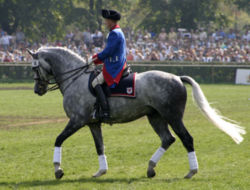
White or true albino horses: the W gene
If a horse possesses the dominant allele W, it will, starting from birth, lack pigment in both skin and hair. The skin is pink and the hair white. The eyes brown are usually brown, but can be blue. This horse is called white, or sometimes, albino. The W allele is rare. All horses that are homozygous for the recessive pigment allele are ww, and those horses include every one of the other colors discussed in this article. In other words, all non-white (meaning non-albino) horses are ww.
Roan horses
Dilution genes: The creme gene
Unlike many other mammals, horses are that are albino are not simply unusual, but unhealthy. When a horse has light eyes and pink skin, along with a light coat the gene at work is usually a dilution gene, rather than some form of lethal white. [4]. The creme gene codes for a modification of color, in its dominant form, CR, there is no modification. A heterozygous recessive, CR/cr, will lighten coat color and a doubly recessive creme gene, cr/cr will doubly lighten it. The resulting color will depend on the base color of the horse and other factors, as outlined below.
Buckskin
Dilution of a bay horse results in buckskin coloration (EE Aa Crcr) . This horse will have at least one copy of the dominant agouti gene, A, so that black pigment on the coat is relegated to the mane, tail and points. A well-marked buckskin horse has a tan body, black mane and tail, and black "socks".
There are additional modifications to the body coat color that are known by the colloquial terms "smutty buckskin", "sooty buckskin" and "black buckskin", when a percentage of body hairs are entirely dark.
Grulla
Smoky black
Dilution of a black horse results in smoky black coloration. Such a horse, like all black horses, will be doubly recessive for the agouti allele and black pigment will be evenly spread along each hair.
Smoky cream
A black horse who has a double dose of the recessive cr gene will not look black at all, but cream colored.
Palomino
A chestnut horse (also caled sorrel) with a single dilute gene yields a palomino horse (ee CR cr aa) . Like the buckskin, there can be additional modifications of coat color. A so-called "chocolate palomino" occurs when XXX. The Paso fino Tomaria's Gallardo is an example of a chocolate or smutty palomino. Palomino's body color can be red enough that the horse might look chestnut, except for its light mane and tail, and the body color can be light enough to look nearly white.
Cremello
This horse has a cream-colored coat that can range from a rather deep cream to near white. It is a doubly dilute form of a chestnut horse, and will have pink skin and blue eyes. Sun protection is helpful for these animals because they will experience sunburn with prolonged exposure.
Perlino
Another double dilute, the perlino XXX
Paint or pinto patterns
Medicine hat
Overo
Tobiano
Spotted Horses
Image:Knabstrupper Baron.jpg
Blue-eyed horses
Color in Racehorses
Some geneticists. along with horsebreeders and racing entusiasts, have speculated that the color of a horse might correlate with factors that influence speed. This notion may seem naive to those who have a basic grounding in genetics, but oddly enough to both those people who have no understanding of molecular genetics, and to those who have a great deal of sophisticate dknowledge of that field, it's a plausible theory.
Genetic testing
Various laboratories around the world offer genetic testing of horses on either a research or commercial basis. The University of California at Davis Veterinary Genetics Laboratory is one such facility.
Further Reading
D. Phillip Sponenberg & Bonnie V. Beaver: Horse Color: A comprehensive and standardized system to describe and classify all colors and patterns of the world's horses.
